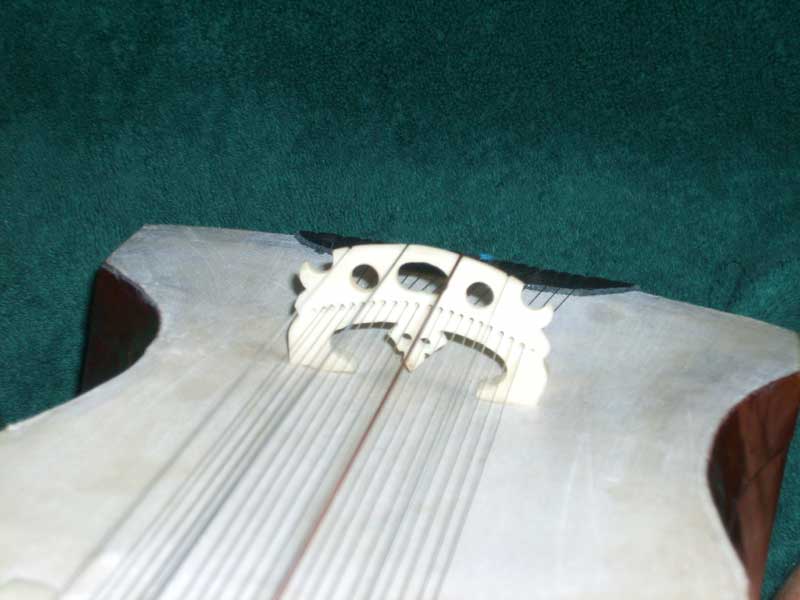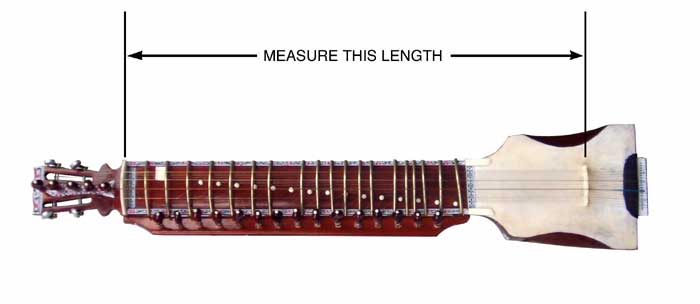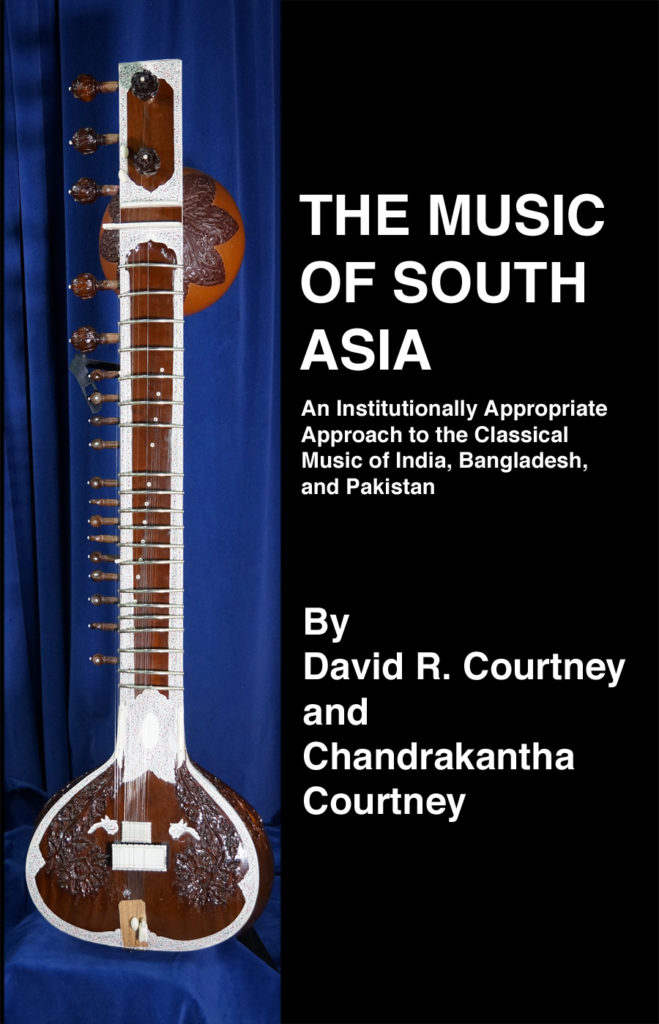Tuning and Stringing the Dilruba or Esraj

| STRINGING AND TUNING THE DILRUBA AND ESRAJ Section 1 – Introduction Section 2 – Basic Concepts of Tuning Section 3 – Overview of Strings Section 4 – Dilruba/Esraj Strings Section 5 – Tools Section 6 – Stringing the Base Section 7 – Stringing the Tuning Pegs Section 8 – Tightening the Strings |
Before going further into the topic of stringing and tuning your instrument, it is important to know what you have got. You can always experiment with different gauges of strings until you find something you like, but we are making things easier by giving charts with different gauges. But these charts mean nothing without a basic knowledge of how long your dilruba is.
For the rest of this article you will need to know the distance from bridge-to-bridge. Simply measure according to the picture below:

If the bridge-to-bridge length is between 25-27 inches (64-70cm) then this will be considered to be a small instrument.
If the bridge-to-bridge length 27-31 inches (70-80cm) then this is considered to be a large one.
| Diameter (Inches) | Diameter (mm) | Pitch (Large Instrument) | Pitch (Small Instrument) | Guitar String |
| .008 | .203 | 4D | 4E | 1st (very light) |
| .009 | .228 | 3B | 4C# | 1st (light) |
| .010 | .254 | 3A | 4B | 1st (standard) |
| .011 | .279 | 3F# | 3A# | 1st (standard), 2nd (very light) |
| .012 | .304 | 3G | 3A | 1st (heavy), 2nd (light) |
| .013 | .330 | 3F | 3G | 1st (heavy), 2nd (standard) |
| .014 | .355 | 3E | 3F# | 1st (heavy), 2nd (standard) |
| .015 | .381 | 3D# | 3F | 1st (very heavy), 2nd (standard), 3rd (very light) |
| .016 | .406 | 3D | 3E | 1st (very heavy), 2nd (standard), 3rd (light) |
| .017 | .431 | 3C# | 3E | 2nd (heavy), 3rd (standard) |
| .018 | .457 | 3C# | 3D# | 2nd, (heavy), 3rd (standard) |
| .019 | .482 | 3C | 3D | 2nd (very heavy), 3rd (standard) |
| .020 | .508 | 2B | 3C# | 2nd (very heavy), 3rd (heavy) |
| .021 | .533 | 2A# | 3C | 3rd (heavy) |
| .022 | .558 | 2A# | 3C | 3rd (heavy) |
| .023 | .584 | 2A | 2B | 3rd (heavy) |
| .024 | .609 | 2G# | 2A# | 3rd (very heavy), 4th (very light) |
| .025 | .635 | 2G# | 2A# | 3rd (very heavy), 4th (light) |
| .026 | .660 | 2G | 2A | 3rd (very heavy), 4th (standard) |
| .027 | .685 | 2G | 2A | 4th (standard) |
| .028 | .711 | 2F# | 2G# | 4th (standard) |
| .029 | .736 | 2F | 2G# | 4th (heavy) |
| .030 | .762 | 2F | 2G | 4th (heavy) |
| .031 | .787 | 2F | 2G | 4th (heavy) |
| .032 | .812 | 2E | 2F# | 4th (heavy), 5th (very light) |
| .033 | .838 | 2E | 2F# | 4th (heavy), 5th (very light) |
| .034 | .863 | 2D# | 2F | 4th (heavy), 5th (light) |
| .035 | .889 | 2D# | 2F | 4th (heavy), 5th (standard) |
| .036 | .914 | 2D# | 2F | 4th (very heavy), 5th (standard) |
| .037 | .939 | 2D | 2E | 4th (very heavy), 5th (standard) |
| .038 | .965 | 2D | 2E | 4th (very heavy), 5th (standard) |
| .039 | .990 | 2C# | 2D# | 5th (standard) |
| .040 | 1.02 | 2C# | 2D# | 5th (heavy) |
| .041 | 1.04 | 2C | 2D | 5th (heavy) |
| .042 | 1.07 | 2C | 2D | 5th (heavy), 6th (very light) |
| .043 | 1.09 | 1B | 2C# | 5th (heavy), 6th (very light) |
| .044 | 1.12 | 1B | 2C# | 5th (very heavy), 6th (light) |
| .045 | 1.14 | 1B | 2C# | 5th (very heavy), 6th(standard) |
| .046 | 1.17 | 1A# | 2C | 5th (very heavy), 6th(standard) |
| .047 | 1.19 | 1A# | 2C | 5th (very heavy), 6th (standard) |
| .048 | 1.22 | 1A# | 2C | 6th (standard) |
| .049 | 1.24 | 1A | 1B | 6th (heavy) |
| .050 | 1.27 | 1G# | 1B | 6th (heavy) |
| .051 | 1.30 | 1G# | 1A# | 6th (heavy) |
| .052 | 1.32 | 1G# | 1A# | 6th (heavy) |
| .053 | 1.35 | 1G | 1A# | 6th (very heavy) |
| .054 | 1.37 | 1G | 1A | 6th (very heavy) |
| .055 | 1.40 | 1G | 1A | 6th (very heavy) |
| .056 | 1.42 | 1G | 1A | 6th (very heavy) |
* All strings are steel strings. The lighter gauge strings are solid while the heavier gauge strings are half round polished steel over steel core (electric guitar strings).
*When dealing with titanium wound, aluminium wound, or fully round wound strings, increase the recommended pitch by half a step.
*When dealing with phosphor bronze, bronze, or brass wound strings, decrease the recommended pitch by half a step.
| Are you interested in a secular approach to teaching Indian music. |
|---|
Indian music is traditional taught in a fashion that is linked to Hindu world views. But there are situations, often in schools, where this approach may not be the best. In such situations The Music of South Asia may be the best resource for you. |
Let us examine each column in detail. The first column is the diameter of the wire expressed in inches. The second column is the diameter of the string expressed in millimetres. The third column is where this string will tune to on a larger instrument. The fourth column is where it will tune to on a smaller instrument. The fifth column is how music shops will describe the string. The last column is totally irrelevant for our instrument, but it does give you a clue as to what to ask for if you go into a mainstream music store.
One must not forget that this is merely a rule of thumb. I am fairly confident that metal strings of the specified gauges will all work in the pitches indicated. But we must remember that there are a very large number of variables, especially in wound strings. Such variables may mean that tuning the string in this manner may sometimes put the sting a bit on the tight side and in other cases it may be on the loose side. In other words, it may begin to be working outside of its “sweet zone”. Again this underscores the need for your own experimentation.
What Does All of This Mean?
At this point, I know that some of you are wondering what all of this means. First of all, I presume that you have thoroughly read Basic Concepts of Tuning as well as this page, and that you are thoroughly comfortable with the material covered in both of these pages. If this is the case, there is really only one piece of the puzzle left. That is how to tie the floating Sa,Re,Ga,Ma together with the solidly anchored A,A#,B,C pitches. I have prepared a table to assist you in this. Simply go to: Western / Indian Note Equivalents, and this will let you tie everything together.
High Side or Low Side?
We must not forget that the usable ranged of the strings on the dilruba or esraj is really rather large. The previous chart is intended to place us in the middle of this usable range for each string. However, there are a number of reasons for us to veer on the tight side or the loose side.
Many musicians like to use a little heaver gauge string for the main playing strings; this makes the string very tight. One advantage of this is that it makes the sound of our instrument very loud. This is extremely important in real-world situations, where it is sometimes difficult just to hear yourself when you are on stage. However, there are also disadvantages to this approach. One disadvantage is that sometimes you are imparting so much energy to the instrument that the sympathetic strings start to hit against either other strings or the small posts to which they are attached. This creates a very unpleasant rattling sound. Another disadvantage is that the sound of our instrument can become very thin. It begins to sound more like a cello and less like a sarangi. One other disadvantage is that it makes the string less responsive; this can be very hard on a beginner who is still struggling with their bowing technique.
On the opposite end of the spectrum, many musicians like to string the gauge with much lighter gauges strings. On the positive side, this makes the dilruba much more responsive, so the small latency one feels when you first start to bow is minimised. Another characteristic of putting light strings for the main playing strings, is that it gives a good, rich, thick, buzzing sort of sound that is reminiscent of the sarangi. When one plays a dilruba or esraj that has been strung with light playing strings, ones performance becomes rich and multitextured. I must admit that this is purely a question of personal taste. I love the rich sound of light playing strings, but I can understand that many musicians might prefer the thinner, purer, sound that comes from a heavy string. The greatest disadvantage of using light playing strings is that the sound becomes very soft. It can be a very big problem on stage if you are not getting a full volume. Furthermore, if you are using light playing strings and have not compensated by putting light gauge sympathetic strings, you may find that your sympathetics are just not singing like they should.
Whether you wish to veer to the heaver gauges or the lighter gauge playing strings is a question of taste. This once again underscores the need for your own experimentation.
Cello Strings
I am not going to waste a lot of time talking about the cello string. I will get right to the Khaas Baat. Cello strings have been designed for bowing and have all of the right surface characteristics. If you buy the full size cello strings, the length is perfect. The materials are excellent. In spite of all of this, you may not want to waste your time with cello strings. They are just not available in gauges fine enough for the main playing string. It is true that they seem to be superior for the heavier strings such as the second and third string of the dilruba and esraj, but cello strings are really expensive.
The bottom line is this. Most people will find that the 1st and 2nd string of the cello works fine for the 2nd and 3rd string of the dilruba (MaSaPaSa or MaSaPaPa tuning). Most people will find that it works better than the common alternatives (i.e., traditional dilruba / esraj or guitar strings). But is it worth the extra cost to you? Only you can decide that.
| STRINGING AND TUNING THE DILRUBA AND ESRAJ Section 1 – Introduction Section 2 – Basic Concepts of Tuning Section 3 – Overview of Strings Section 4 – Dilruba/Esraj Strings Section 5 – Tools Section 6 – Stringing the Base Section 7 – Stringing the Tuning Pegs Section 8 – Tightening the Strings |